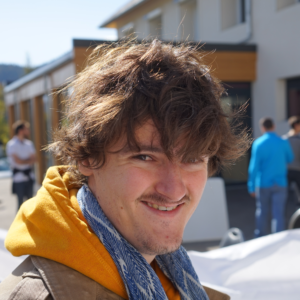
thomas.guillet
Vendredi 16 Octobre 2020 à 14H00, Thomas Guillet soutiendra sa thèse, intitulée :
Utilisation du couplage spin-orbite dans le germanium pour la génération, la détection et la manipulation du spin
Lieu : CEA, Bat 10.05 auditorium 445 (complet)
visio : join Skype Meeting. In case of failure or on Phone/Tablet install the Skype for Business mobile app and clic on the link : Skype Web App.
Résumé : Au fil des années, plusieurs schémas d’injection et de détection de spin ont été réalisés dans Ge, mais la manipulation électrique de l’orientation du spin est toujours une pièce manquante. Dans cette thèse, nous nous sommes concentrés sur deux approches afin de manipuler l’interaction spin-orbite dans le germanium. Les deux s’appuient sur l’absence de symétrie d’inversion aux interfaces avec le germanium (111).
Dans un premier temps, j’ai étudié les propriétés structurales et électriques de l’hétérostructure Bi2Se3/Ge puis j’ai développé une méthode originale pour sonder la conversion courant de spin-courant de charge à l’interface entre Bi2Se3 et Ge en tirant profit des propriétés optiques du Ge.
La seconde approche consiste à exploiter le couplage spin-orbite intrinsèque de Ge (111). J’ai étudié les propriétés électriques d’un film mince de Ge (111) et découvert que le passage du courant dans des états de sous-surface où l’interaction Rashba est forte, induit un effet de magnétorésistance très particulier que nous avons appelé la magnétorésistance Rashba unidirectionnelle.
Enfin, j’ai rassemblé tous les éléments développés pendant mon travail de thèse dans un dispositif ultime: un prototype de transistor à spin où des accumulations de spins peuvent être générées électriquement ou optiquement, en utilisant l’orientation optique de spin dans le germanium ou l’injection par des jonctions tunnel magnétiques.
English : Tuning the spin-orbit coupling in germanium for spin generation, detection and manipulation
abstract : throughout the years, several spin injection and detection schemes have been achieved in Ge but the electrical manipulation of the spin orientation is still a missing part. In this thesis, we focused on two approaches in order to tune the spin-orbit interaction (SOI) in a Ge-based platform. Both rely on the inversion asymmetry and the spin-orbit coupling at interfaces with germanium (111).
First, I studied the structural and electrical properties of Bi2Se3/Ge heterostructures and developed an original method to probe the spin-to-charge conversion at the interface between Bi2Se3 and Ge by taking advantage of the Ge optical properties.
The second approach consists in harnessing the SOI of Ge (111). By investigating the electrical properties of a thin Ge (111) film, I discovered that an electrical current flowing in sub-surface states where the Rashba interaction is strong, leads to a new magnetoresistance effect that we named Unidirectional Rashba Magnetoresistance.
Finally, I assembled all these building blocks studied during my PhD work to build a prototypical spin transistor. The spin accumulation was generated either optically or electrically, using optical spin orientation in germanium or the injection by magnetic tunnel junctions.
Le jury:
Président du jury :
Pr., David, Ferrand Professeur, Université Grenoble Alpes
Rapporteurs :
Pr., Sergio, Valenzuela Professeur, Institut Català de Nanociència i Nanotechnologia
Pr., Pierre, Renucci Enseignant-Chercheur, INSA Toulouse
Examinateurs :
Pr., Masashi, Shiraishi, Professeur, Université de Kyoto
Dr., Jean-Marie, George, Directeur de recherche, CNRS Thales
Membre invité :
Dr., Federico, Bottegoni Enseignant-Chercheur, Politecnico di Milano




